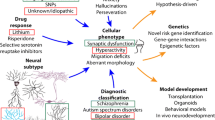Abstract
It is a challenge to establish and use model systems for the study of complex neuropsychiatric diseases such as schizophrenia (SZ) and autism spectrum disorder (ASD). The development of induced pluripotent stem cell (iPSC) technologies now offers a promising approach which faithfully represents the varying genetic background of individual patients. Phenotypic analysis of iPSC-derived neurons reveals differences at the level of transcriptomes and calcium signalling allowing for a specific discrimination between SZ and ASD phenotypes.
Similar content being viewed by others
Literatur
Grunwald LM, Stock R, Haag K et al. (2019) Comparative characterization of human induced pluripotent stem cells (hiPSC) derived from patients with schizophrenia and autism. Transl Psychiatry 9:179
Topol A, Zhu S, Tran N et al. (2015) Altered WNT signaling in human induced pluripotent stem cell neural progenitor cells derived from four schizophrenia patients. Biol Psychiatry 78:e29–e34
Brennand KJ, Simone A, Jou J et al. (2011) Modelling schizophrenia using human induced pluripotent stem cells. Nature 473:221–225
Pasca SP, Portmann T, Voineagu I et al. (2011) Using iPSC-derived neurons to uncover cellular phenotypes associated with Timothy syndrome. Nat Med 17:1657–1662
Robicsek O, Karry R, Petit I et al. (2013) Abnormal neuronal differentiation and mitochondrial dysfunction in hair follicle-derived induced pluripotent stem cells of schizophrenia patients. Mol Psychiatry 18:1067–1076
Wen Z, Nguyen HN, Guo Z et al. (2014) Synaptic dysregulation in a human iPS cell model of mental disorders. Nature 515:414–418
Doers ME, Musser MT, Nichol R et al. (2014) iPSC-derived forebrain neurons from FXS individuals show defects in initial neurite outgrowth. Stem Cells Dev 23:1777–1787
Marchetto MC, Carromeu C, Acab A et al. (2010) A model for neural development and treatment of Rett syndrome using human induced pluripotent stem cells. Cell 143:527–539
Shcheglovitov A, Shcheglovitova O, Yazawa M et al. (2013) SHANK3 and IGF1 restore synaptic deficits in neurons from 22q13 deletion syndrome patients. Nature 503:267–271
Yoon SJ, Elahi LS, Pasca AM et al. (2019) Reliability of human cortical organoid generation. Nat Methods 16:75–78
Mariani J, Coppola G, Zhang P et al. (2015) FOXG1-dependent dysregulation of GABA/glutamate neuron differentiation in autism spectrum disorders. Cell 162:375–390
Stachowiak EK, Benson CA, Narla ST et al. (2017) Cerebral organoids reveal early cortical maldevelopment in schizophrenia-computational anatomy and genomics, role of FGFR1. Transl Psychiatry 7:6
Author information
Authors and Affiliations
Corresponding authors
Additional information
Ricarda Stock2015–2017 Masterstudium Molekulare Zellbiologie und Immunologie an der Universität Tübingen. Seit 2018 Promotionsstudium der Molekularen Neurobiologie am Naturwissenschaftlichen und Medizinischen Institut (NMI) an der Universität Tübingen, Reutlingen.
Hansjürgen Volkmer1979–1989 Biologiestudium und Promotion an der Universität Tübingen. 1989–1993 Zentrum für Molekulare Neurobiologie, Hamburg. 1993–1997 Max-Delbrück-Centrum, Berlin-Buch. Seit 1998 Gruppenleiter und Bereichsleiter am Naturwissenschaftlichen und Medizinischen Institut (NMI) an der Universität Tübingen, Reutlingen.
Rights and permissions
About this article
Cite this article
Stock, R., Volkmer, H. Psychiatrische Erkrankungen mit Stammzelltechnologien verstehen. Biospektrum 26, 46–49 (2020). https://doi.org/10.1007/s12268-020-1321-6
Published:
Issue Date:
DOI: https://doi.org/10.1007/s12268-020-1321-6




